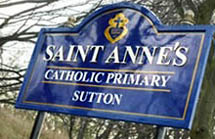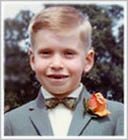In 1856 when Rev. Henry Vallancey was seeking funds for his new Church of England schools, he referred in his correspondence to a day school attached to St. Anne's Church. This was then the only public school situated near the main working Sutton population. It had opened three years earlier as a single schoolroom attached to the monastery. When the nuns of the Sisters of the Cross and Passion led by Elizabeth Prout began teaching at St. Anne's school in July 1855, there were only 40 girls. However the Passionist church congregation grew quickly and by 1861 there were 2000 parishioners whose children needed educating.
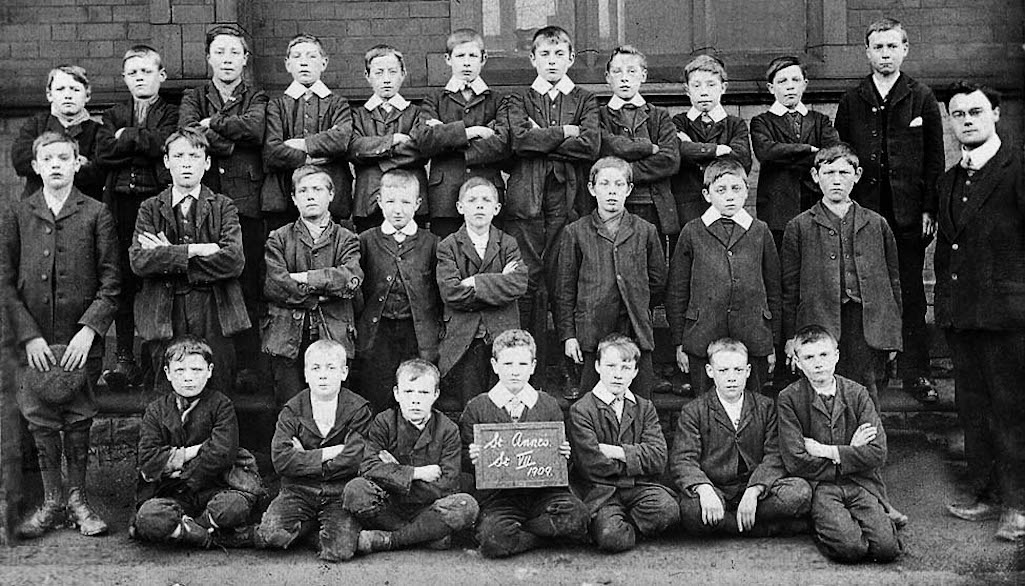
Some of these St. Anne's boys' clothes pictured in 1909 have seen better days - Contributed by John Barton

Some of these St. Anne's boys' clothes from 1909 have seen better days

Class photo of St. Anne's boys in 1909
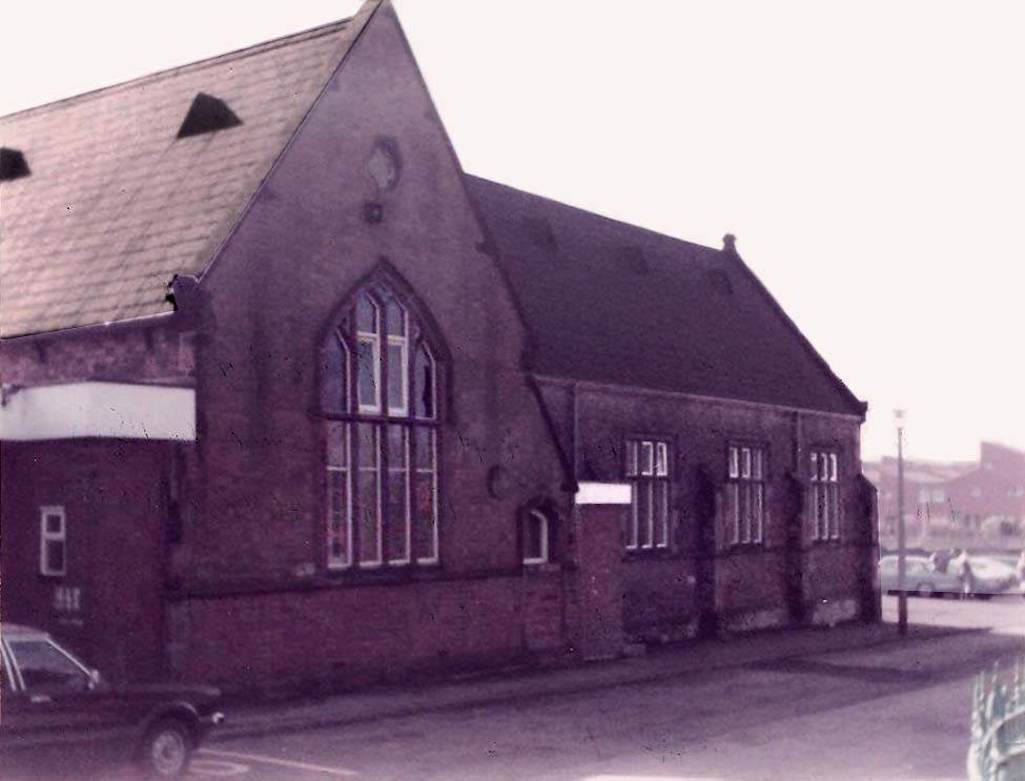
The old St. Anne's Roman Catholic boys school - contributed by Ian H. Campbell

The old St. Anne's Roman Catholic boys school in Sutton, St.Helens

The old St. Anne's boys school
However Smith – who was a director of the St Helens Canal & Railway Company – died in 1863 and the Borrows' Providence foundry in Peckers Hill Road, that was named after their Roman Catholic faith, only began operating in 1868. It took some years before they became successful and able to provide financial support to their church. So raising sufficient funds for a new school was a slow process. However by April 1869 they had sufficient cash to make a start on a new boys' school, along with an adjacent cottage for a master. A girls' school was also needed but that would have to wait until sufficient funds were available.
The St Helens Newspaper said the building would be constructed in the "Tudor or late perpendicular style of English - Gothic architecture”. The internal length of the schoolroom would be 53 feet and it would be 20 feet wide and 29 feet high. The architect was Joseph Smart of Westfield Street and Fishers of Sutton had been contracted as the builders. The newspaper added that the total cost for the boys' school and the master's house had been set at £1,800.
On April 11th 1869 the foundation stone was laid by Fr. Bernardine from London before what the Liverpool Mercury described as a “vast concourse” of people. After a church service, a procession was formed which included members of the Sutton Catholic Philanthropic Society and Peasley Cross Guild, plus a number of little girls dressed in white and wearing long flowing veils and coronets of flowers. Within the stone that was ceremoniously laid, a time capsule was inserted which contained coins, documents and a local newspaper. The new school building was completed in 1870 and built on the opposite side of the road to the monastery. It accommodated 500 pupils and the master and mistress around 1880 were Thomas Bate George and his Irish wife Mary. In the later years of the 1880s, a Mr. Bate was the headmaster.
A new wing was added to the school not long after its construction, however the building soon proved inadequate. So on September 16th 1883, the foundation stone for a new girls' school was laid. It was opened on April 22nd 1884 at a cost of £1500 and was designed by architect Albert Vicars and built by Fisher's builders of Sutton. It was constructed in a Gothic style out of bricks with stone dressings and measured sixty feet by twenty-seven feet. For many years the nuns of the Sisters of the Cross and Passion ran the girls’ school at St. Anne’s.
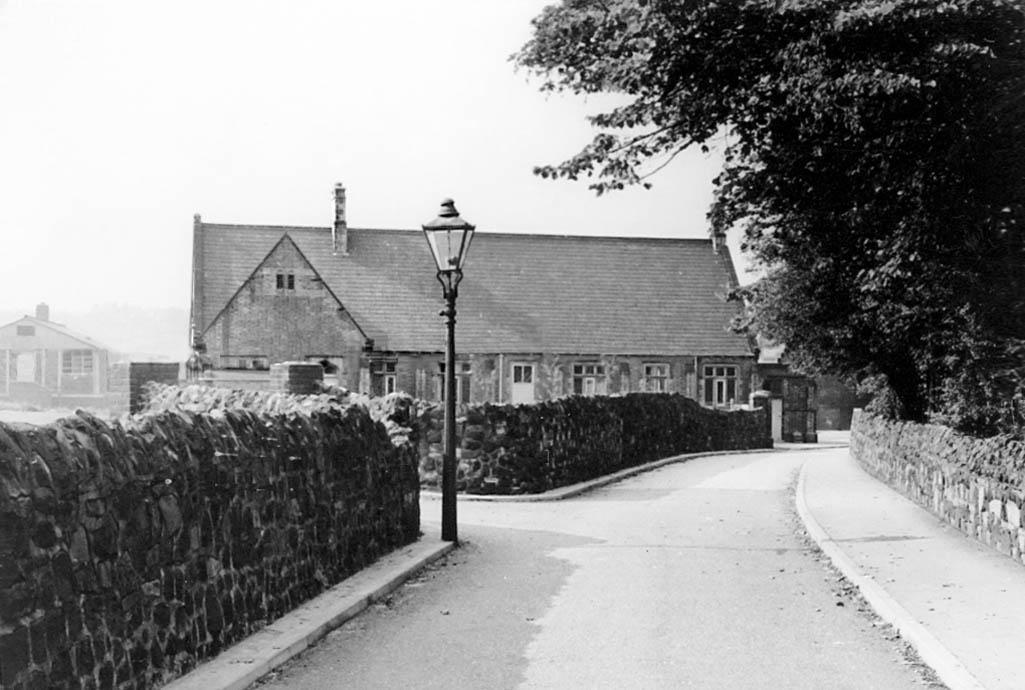
St.Anne's girls’ school photographed by Frank Sheen in 1960 from the Pudding Bag end of a flint walled Monastery Lane

St.Anne's girls’ school taken by Frank Sheen in Monastery Lane in 1960

St.Anne's girls’ school in 1960
On March 2nd 1889 the St.Helens Reporter described how four days earlier the school had been packed with a delighted audience watching children performing the operetta ‘Prairie Life, or Scenes from the Wild West’. St. Anne’s pupils depicted life out west, with their show featuring Annie Oakley, European emigrants and Buffalo Bill’s cowboys taking on the Indians. Songs and dances were performed with 100 children taking part in the chorus. In fact the school productions were feted for their quality. In 1922 the St.Helens Newspaper wrote that: ‘The children’s concerts in St. Anne’s, Sutton have always maintained a standard of excellence rarely equalled elsewhere and in pre-war days were one of the events of the winter time in that quarter of the town’.
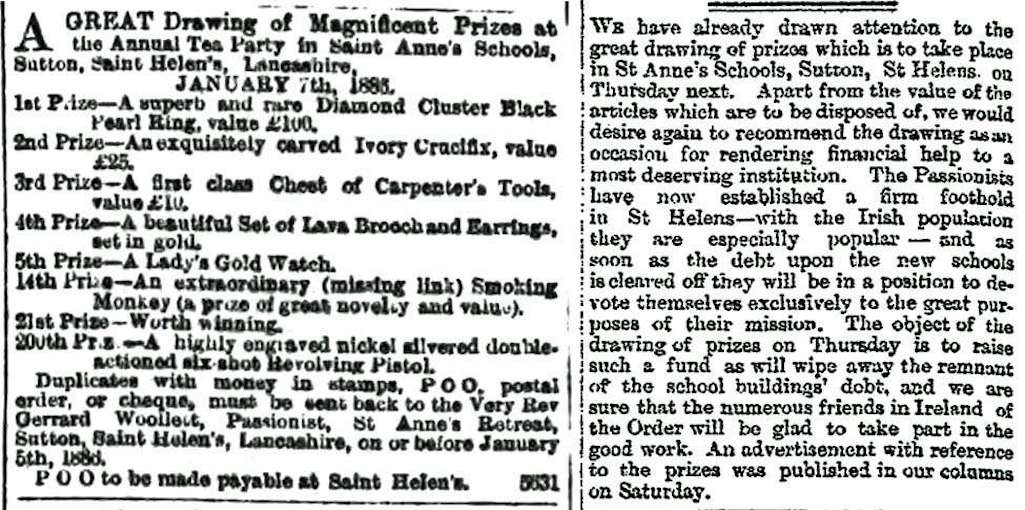
Freeman's Journal and Daily Commercial Advertiser of Dublin - December 5th 1885 and January 4th 1886

Freeman's Journal of Dublin - December 5th 1885 and January 4th 1886

Freeman's Journal 1885 and 1886
Over 1000 boys and girls processed to Mr. Willis's field in Sutton Junction where a fête was held. Roughdale's Brass Band led the procession followed by masters W. Murphy, J. Taylor, Ged Taylor, H. Leadbetter, W. Clare, Geo Jones, Jas Parr, Joe Case, Peter Almond, W. Nolan, P. Holland, and John Ashton. These were the Morris Dancers who performed as the procession journeyed along Church Street and Robins Lane as the newspaper commented:
Much delight was shown by the populace at the artistic evolutions portrayed by these boys...Along the route through the various streets bunting and other decorations enlivened the scene beyond description...When the processionists arrived at the field, the sun shone out magnificently. After about 1000 children had been substantially fed, various sports and entertainments were indulged in. A stage had been erected where the children of Sutton Infants School delighted their hearers with a commendable performance. Miss Bickerstaffe played the harmonium for them most satisfactorily.
The proceeds of the event went towards lessening the debt on the new school build. There were also four fundraising performances by the schoolchildren of Balfe’s opera ‘The Bohemian Girl’ and from June 17th 1896 a four-day bazaar was held in the Catholic Club Room. Both of these events made considerable contributions to clearing off the debt. Not only was there a constant battle to provide funding for a school provision that was regularly expanding but during the twentieth century a war was also waged on subsidence. Serious signs emerged in 1937 but the cracks were only plastered and painted over and in 1948 the infants school was closed.
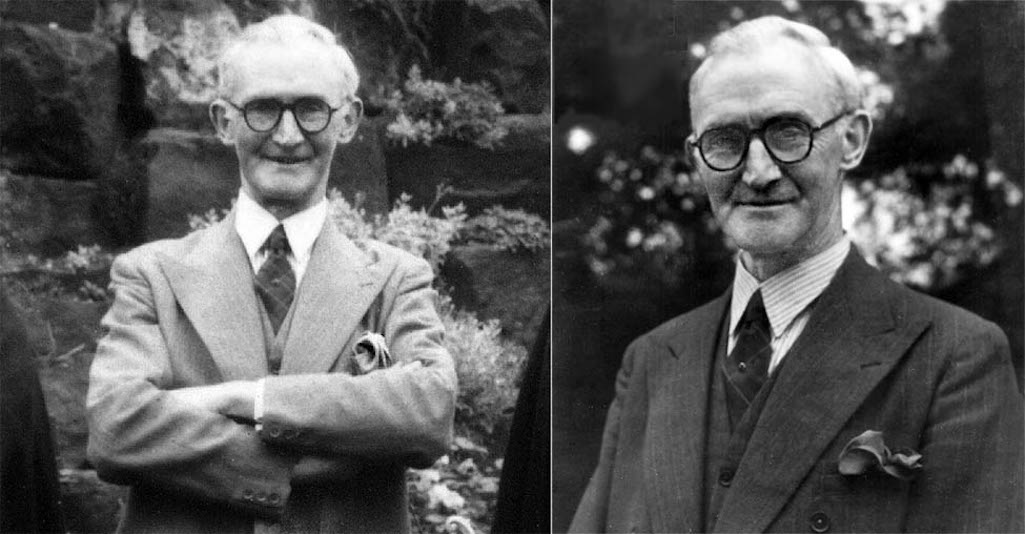
Two photographs of John Duffy who served as headmaster of St.Anne's Boys School from 1913 to 1950

Photos of John Duffy who served as boys’ headmaster from 1913 to 1950

St.Anne’s boys’ head John Duffy
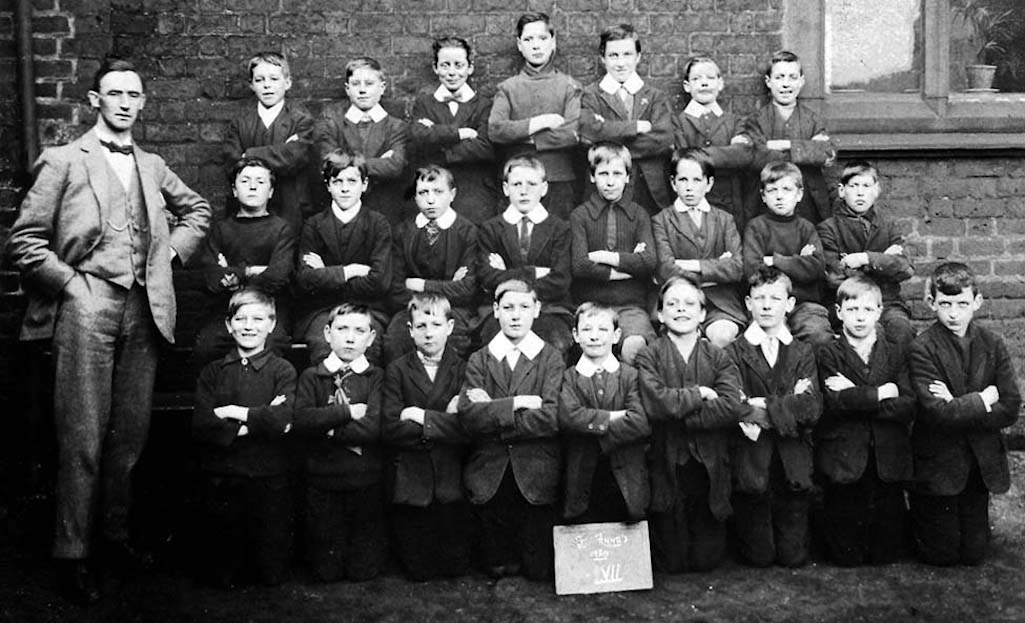
A 1920 class at St.Anne's Roman Catholic Boys School with teacher John Duffy - Contributed by John Barton

1920 class at St.Anne's Boys School with young teacher John Duffy

1920 class with teacher John Duffy
In May 1942 he protested against the excessive admin that heads were now expected to undertake, being responsible for registration statistics, medical cards, milk cards, filing, docketing, requisitions and triplicate stock books. Addressing the NAHT conference in London in June 1943 in a debate on school absenteeism, the St. Anne's head said on one afternoon he'd counted a total of 40 children leaving a St.Helens cinema (probably Sutton 'Bug').
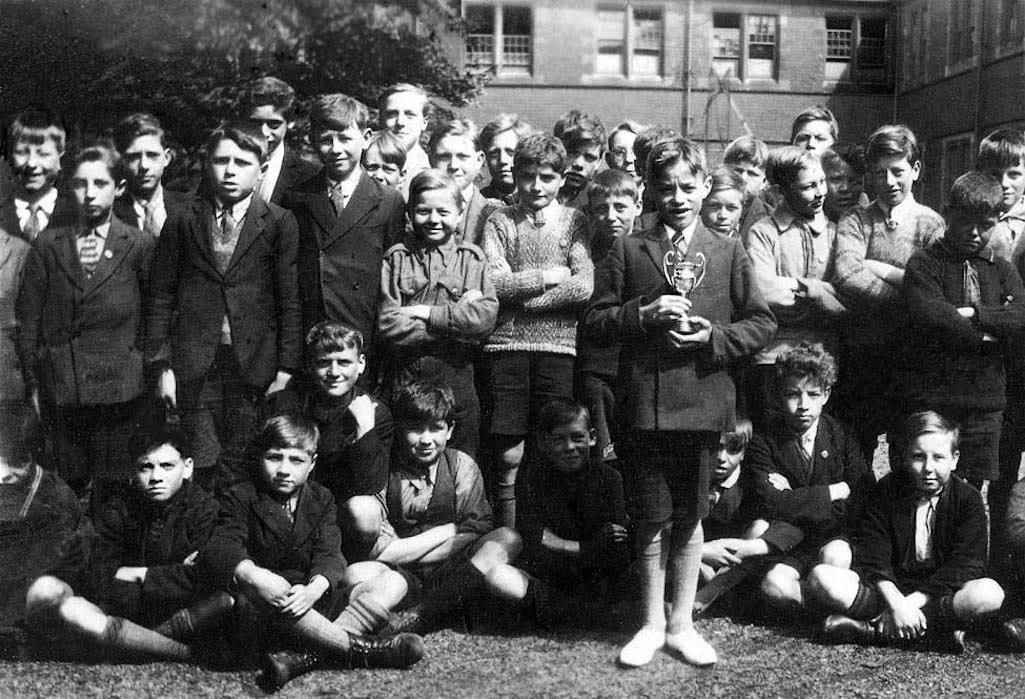
Joseph Kelly pictured about 1930 with a silver cup awarded for seven years unbroken attendance at St.Anne's

Joseph Kelly pictured about 1930 with a silver cup awarded for seven years unbroken attendance at St.Annes RC School in Sutton

Joseph Kelly c.1930 with a silver cup awarded for seven years unbroken attendance at St.Anne's school
It was stated that this could have a detrimental effect on schoolchildren, as head teachers were regularly called away from class. John Duffy criticised the suggestion that pupils could pursue private study during the enforced absences of headmaster / teachers. Comparing his students to animals, Duffy said a lion tamer never takes his attention off lions, adding that a class of 30 to 40 schoolboys could be "as lively as a cage of monkeys".
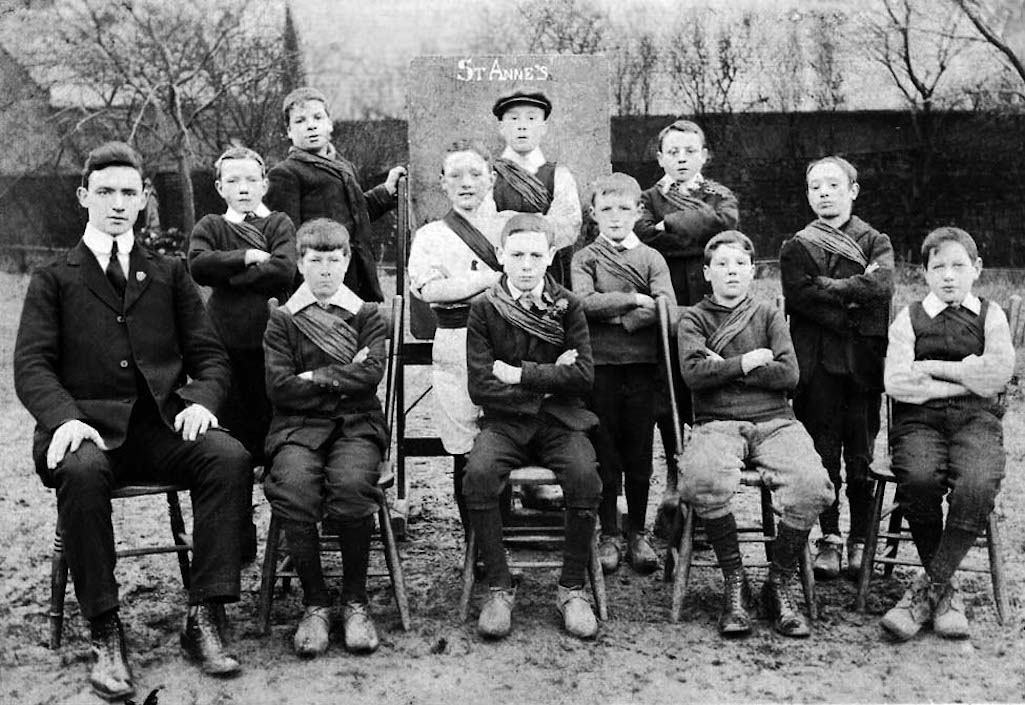
Some St.Anne's boys with John Duffy - the sashes suggest membership of the Catholic Boys' Brigade - Contributed by John Barton

St.Anne's boys with John Duffy - the sashes suggest the Catholic Boys Brigade

Some St.Anne's boys with John Duffy
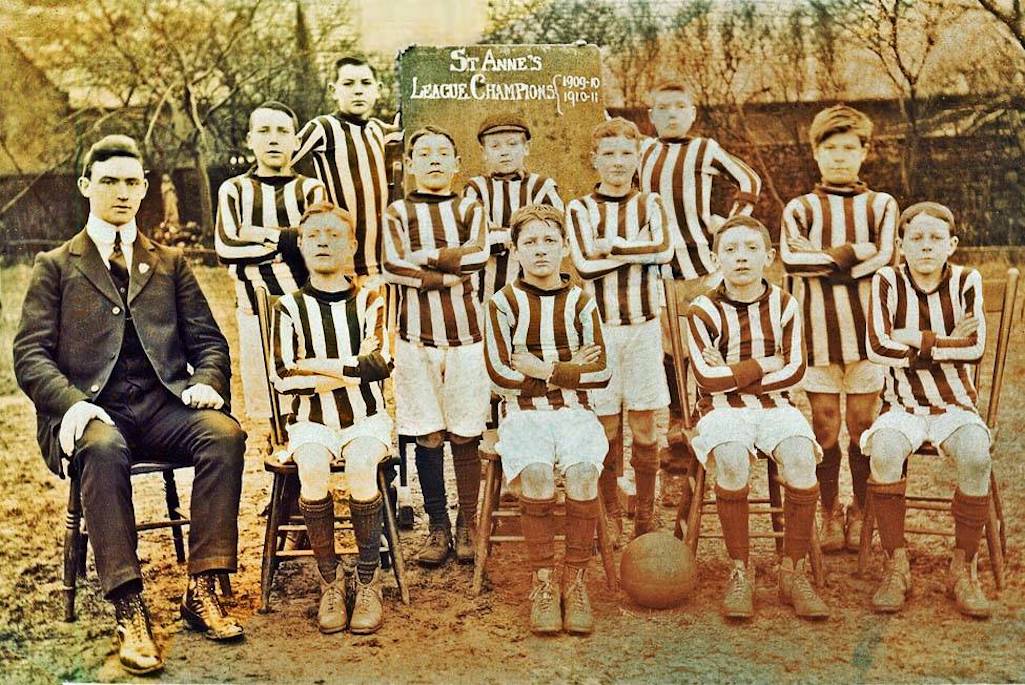
St.Annes School football league champions 1909-10 and 1910-11 with youthful team manager John Duffy

Football league champions 1909-10 & 1910-11 with team manager John Duffy

League champions 1909-10 & 1910-11
Another highlight was in 1939 when pupil James Kenwright played outside left for England in a schoolboy international against Scotland in Edinburgh. To commemorate this success, James - who also played football for Lancashire - was presented with an inscribed silver cup by his head teacher. Pupil Hermann Fairclough also made a presentation of a framed photograph that was to hang in the school. Kenwright signed for Manchester United but the war probably prevented a footballing career.
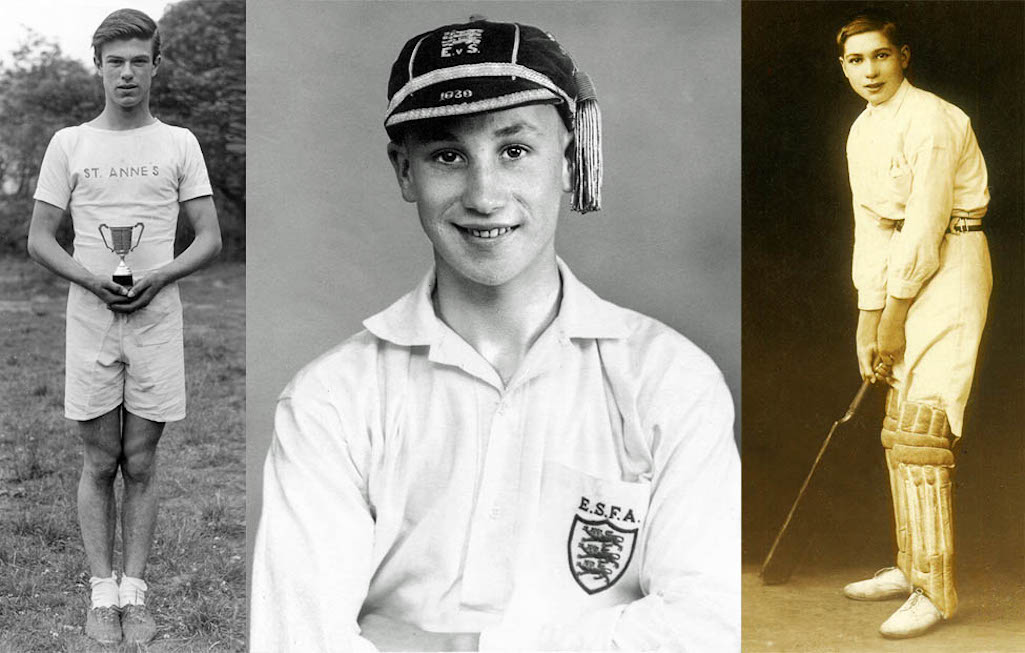
Left: Athlete James Doyle; Middle: footballer James Kenwright; Right: James Smith shows how batsmen used to dress

Athlete James Doyle, footballer James Kenwright and cricketer James Smith

Athlete James Doyle, footballer James Kenwright and cricketer James Smith
It was also a great year for athletics at St.Anne's, with the school relay team the 1950 champions of St.Helens, as well as winners of the Challenge Shield at the Police Sports. In July of that year pupil James Doyle became the all-England schoolboy champion when he won the under 15s 440 yards race at Port Sunlight. In competing James wore the running pumps that had recently been presented to him by St.Anne's C.Y.M.S. in appreciation of his previous successes.
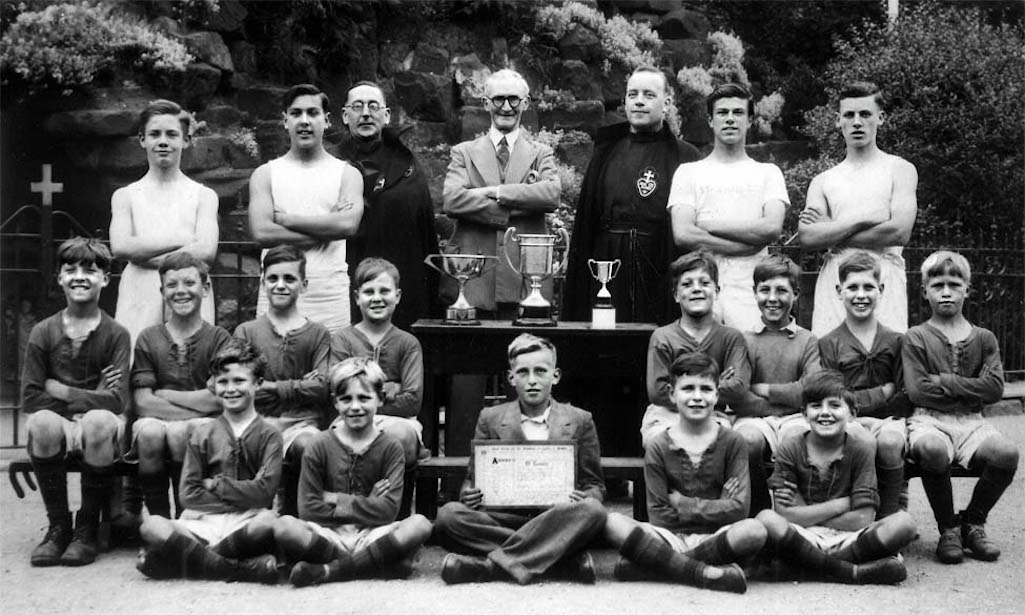
The 1950 cup-winning St.Anne's relay and football teams, plus William Noonan with his RSPCA certificate

The cup-winning St.Anne's relay and football teams, plus William Noonan displaying the RSPCA certificate that he’d been awarded

The 1950 cup-winning relay and football teams, plus William Noonan
The retirement gifts from the people of Sutton also included a clock, easy chair and writing bureau. A grateful Mr. Duffy said "To me these gifts are more valuable than the Crown Jewels". After the ceremony and tributes, there was a concert with performances by renowned tenor Richard Knight (of St. Anne's who had recently performed on Radio Eire), contralto Marjorie Meara and baritone J. Caulfield.
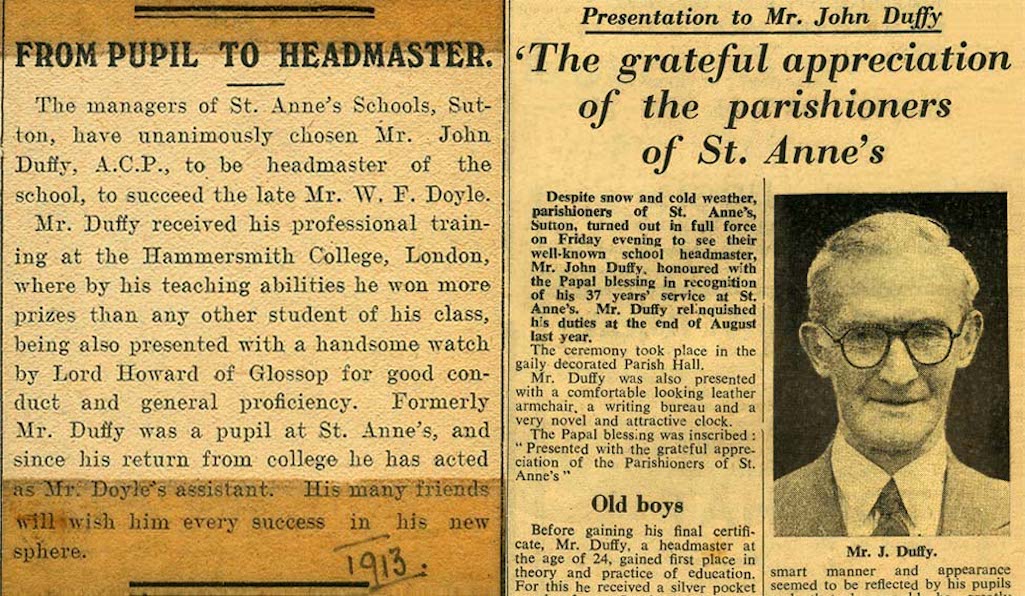
Left: An article published in 1913 on John Duffy's appointment; Right: St.Helens Newspaper January 2nd 1951

Left: Article published in 1913 on John Duffy's appointment as headmaster of St.Anne’s boys school; Right: St.Helens Newspaper January 2nd 1951

Left: 1913 article on John Duffy's appointment as headmaster; Right: St.Helens Newspaper 1951 article
The most worthwhile person I have ever met? I am very fortunate because, of the world's 2,000 millions, I have met 2,000 of them. They are the 2,000 boys for whose education I was responsible during 40 years as a headmaster, a position I gave up with deep regret only a few weeks ago when I retired. When I bade good-bye to the last 200 of that gallant brigade, my heart was filled with pride, gratitude and the deepest emotion. As the years rolled on, I had learned far more from them than they could possibly learn from my carefully devised syllabuses. As a young man of 20, I left training college primed with an extensive knowledge of educational theory and practise. But in daily contact with my young charges, I soon found that the old concept of master and pupil needed revising or reversing if the daily task of advancing education was to be of advantage to my pupils with an assurance of my peace of mind. I soon realised that my-pupils were not a mass but a number of individuals with no two alike; that my job was not just to impose mathematics or geography upon John Jones but to teach him with sympathy and a clear understanding of his individual difficulties and his emotional background. In short, that my job was not simply to instruct but to educate spiritually and socially. This might demand of me greater effort and the burning of midnight oil, but the satisfaction of greater reward amply repaid the time and effort. In the classroom and on the playing field, the spirit of co-operation permeated all activities to the mutual advantage of teacher and pupil. In both spheres of operation, master and pupils learned some of life’s most valuable lessons - perseverance, patience and fairplay. The teacher, like Peter Pan, refused to note the passing years: the white haired schoolmaster was still a boy at heart who could safely allow his sense of humour full play without any loss of prestige. To those 2,000 boys, now widely dispersed, many of them fathers or even grandfathers, I am deeply indebted for the valuable lessons I learned from them and for the happy memories which will brighten my declining years. Those of the number who died in their country's cause always have a remembrance in my prayers.
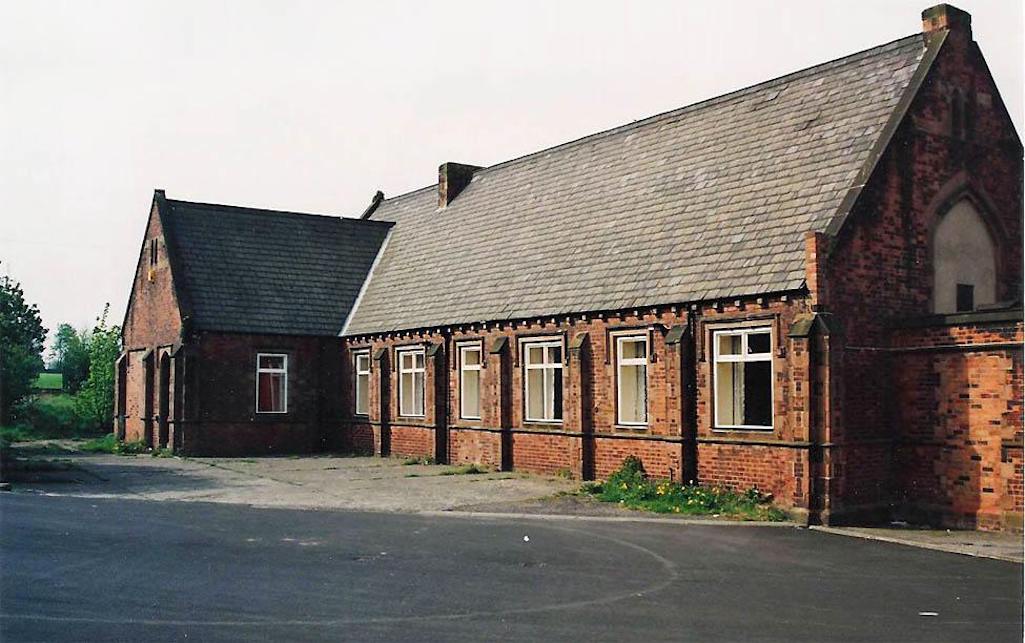
The old St. Anne's Roman Catholic girls school in Sutton - contributed by Ian H. Campbell

The old St. Anne's Roman Catholic girls school in Sutton, long demolished

The old St. Anne's girls school in Sutton
These days Saint Anne's Catholic Primary school has modern premises in Monastery Lane, near to the new church and social centre. It was originally built in 1950 on the site of St. Anne’s Villa, the former home of John Smith. He was the railway man who was a great benefactor to St.Anne’s Church before his death in 1863. The photograph above shows the old girls school built in 1895 and sent into this website by former 'Pudding Bagger' Ian H. Campbell now resident in Atlanta, Georgia. Ian writes:
The portion on the left corner was a class room and a stage and is where the church boys choir used to practice during the winter months. The choir master was Fr. Peter Paul, if I remember correctly. Next to the playground was the infant school, and then further left was the canteen.
Ian has also supplied the photograph of the former St. Anne's boys school at the beginning of this article. He remembers that just inside the front door was the school bell, with its rope hanging down ready to be rung to signal the start and end of classes. The boys school became St. Anne's social club for a while after the club had relocated from its Robins Lane premises and the building was finally demolished around 2002.
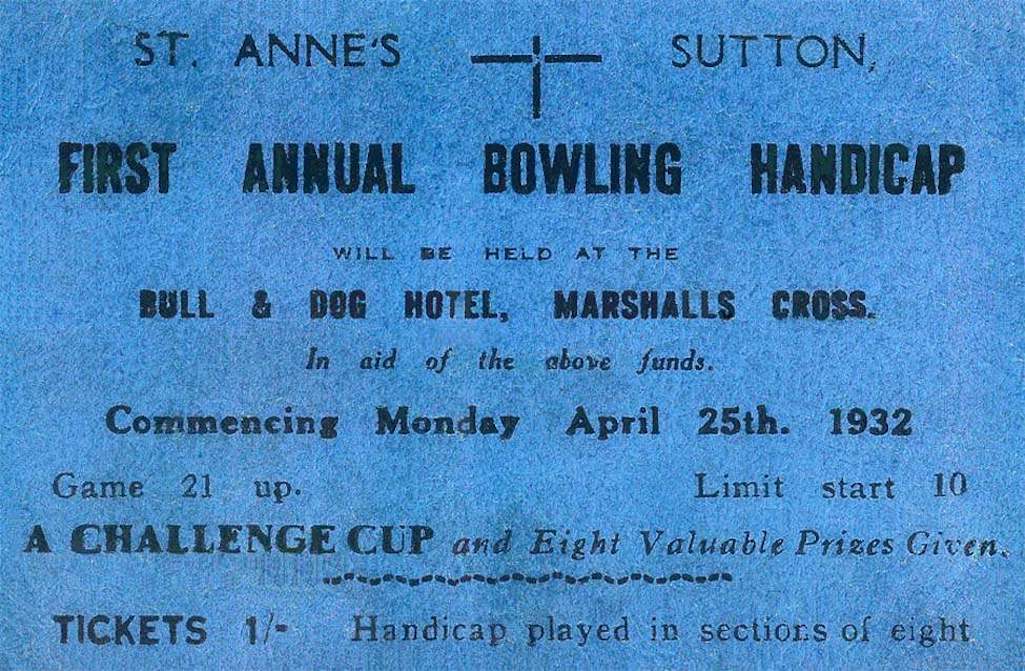
Ticket for the inaugural annual bowling handicap at the Bull & Dog in aid of St.Anne's - contributed by Jim Lamb

Ticket for the bowling handicap at the Bull & Dog in aid of St.Anne's

Bowling match ticket in aid of St.Anne's
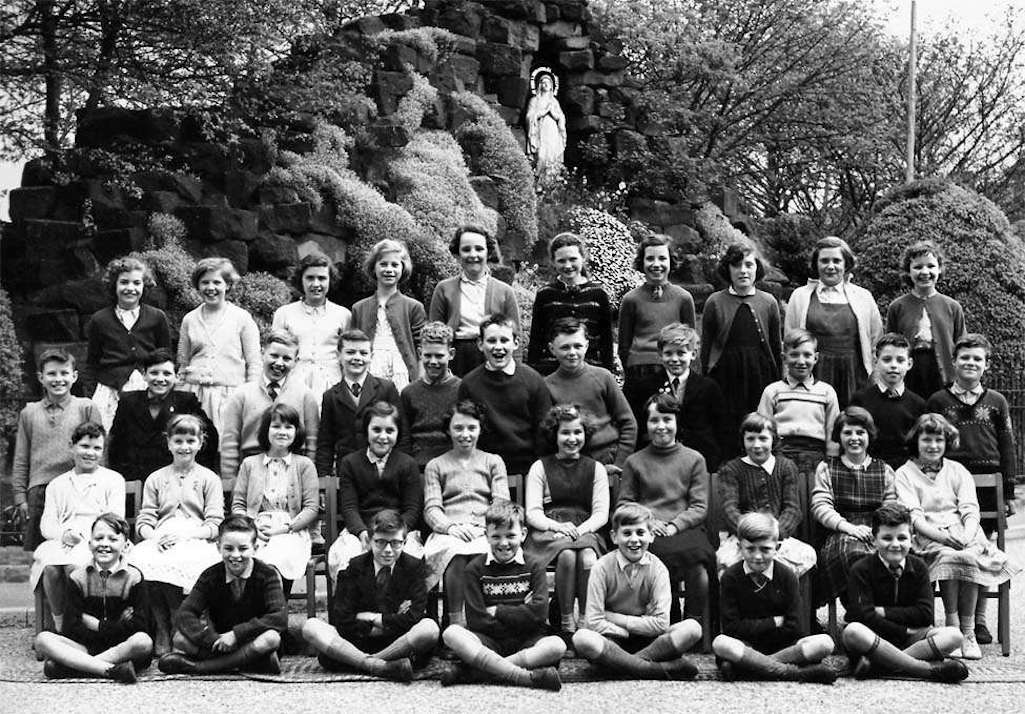
St. Annes class photo c.1957-60







































